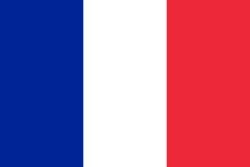Top Qs
Timeline
Chat
Perspective
Flag of Benin
National flag From Wikipedia, the free encyclopedia
Remove ads
The national flag of Benin[1] (French: drapeau du Bénin) is a flag consisting of two horizontal yellow and red bands on the fly side and a green vertical band at the hoist. Adopted in 1959 to replace the French Tricolour, it was the flag of the Republic of Dahomey until 1975, when the People's Republic of Benin was established. The new regime renamed the country and changed the flag to a green field with a red star in the canton. This version was utilized until multi-party democracy was re-established in 1990, coinciding with the Revolutions of 1989. The new government promptly restored the original pre-1975 flag.

Remove ads
History
Summarize
Perspective
Under French colonial rule over Dahomey, French authorities forbade the colony from having its own regional flag. This was because they were worried that this could increase nationalistic sentiment and lead to calls for independence.[2] However, with the rise of the decolonization movement in Africa, the French were obliged to grant limited autonomy to Dahomey as a self-governing republic within the French Community.[3] This was granted on December 4, 1958, and a search for a national flag began soon after.[4]
The new flag was chosen on November 16, 1959, and remained unchanged when Dahomey became independent less than a year later on August 1, 1960.[5] In 1972, a coup d'état took place in the country, with the new government aligning itself with Marxist–Leninist ideals. In order to symbolize the revolutionary change, the country was renamed Benin and a new flag was instituted three years later.[6] It featured a green field charged with a five-pointed red star in the top-left canton.[7] The new flag was never adopted by law, however, making it only the de facto flag of Benin.[1]
The green flag remained in place until 1990, when economic problems and the weakening of the Soviet Union's power due to the Revolutions of 1989 culminated in the collapse of the People's Republic of Benin. The original flag from 1959 was reinstated on August 1, 1990.[5]
Remove ads
Design
The colours of the flag carry cultural, political, and regional meanings. As stated in the national anthem, the green of the flag represent the hope of a new democracy. The red represents the courage of the ancestors, and the yellow is for the treasures of the nation.[8] On a continental level, the yellow, green and red represented the Pan-Africanist movement;[9] the three colours were utilized by the African Democratic Rally, a political party representing the interests of French West Africa in the National Assembly of France at the time of decolonization.[5] Furthermore, the colours are the same as the ones utilized in the flag of Ethiopia.[10] This honours the oldest independent country in Africa and the only nation other than Liberia to remain independent during the Scramble for Africa.[5][11]
Remove ads
Colour scheme
Historical flags
Remove ads
Other flags
Military
- 2:3 Flag of the Benin Armed Forces, obverse side
- 2:3 Flag of the Republican Police, obverse side
- Roundel of the Benin Air Force
- Historical roundel of the Benin People's Air Force (1975–1990)
Gallery
- Faded mural depicting the national flag in Lissègazoun (2021)
- Flags flown in celebration of Fête du Vodoun in Ouidah (2017)
- Beninese men waving the national flag on independence day (2016)
- Flags outside the Embassy of Benin in Tokyo, Japan (2013)
- Beninese flags waving outside the Congress Palace of Cotonou (2009)
- Beninese and United Nations flags flown by the Beninese contingent of MONUSCO (2000)
Remove ads
See also
References
External links
Wikiwand - on
Seamless Wikipedia browsing. On steroids.
Remove ads




















